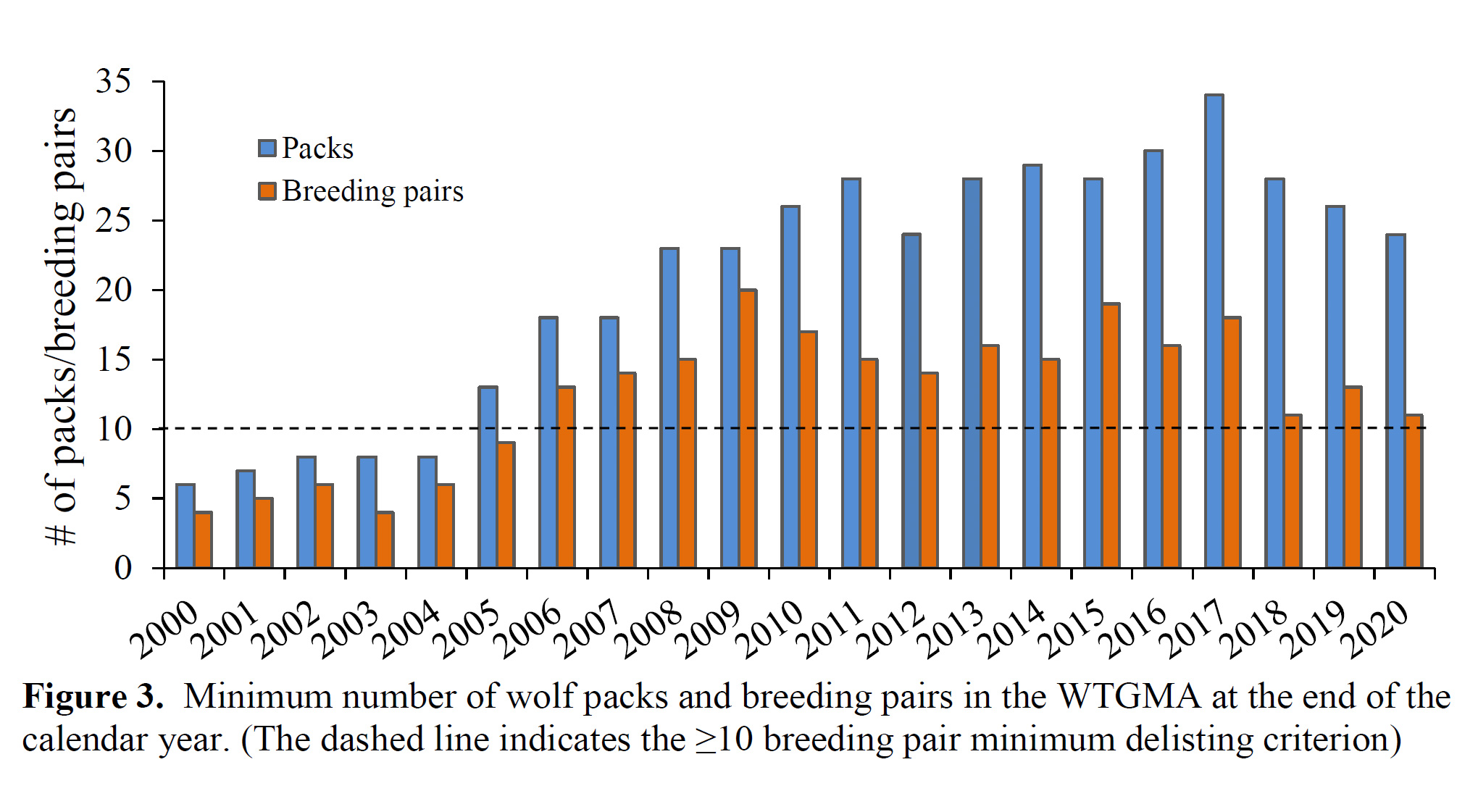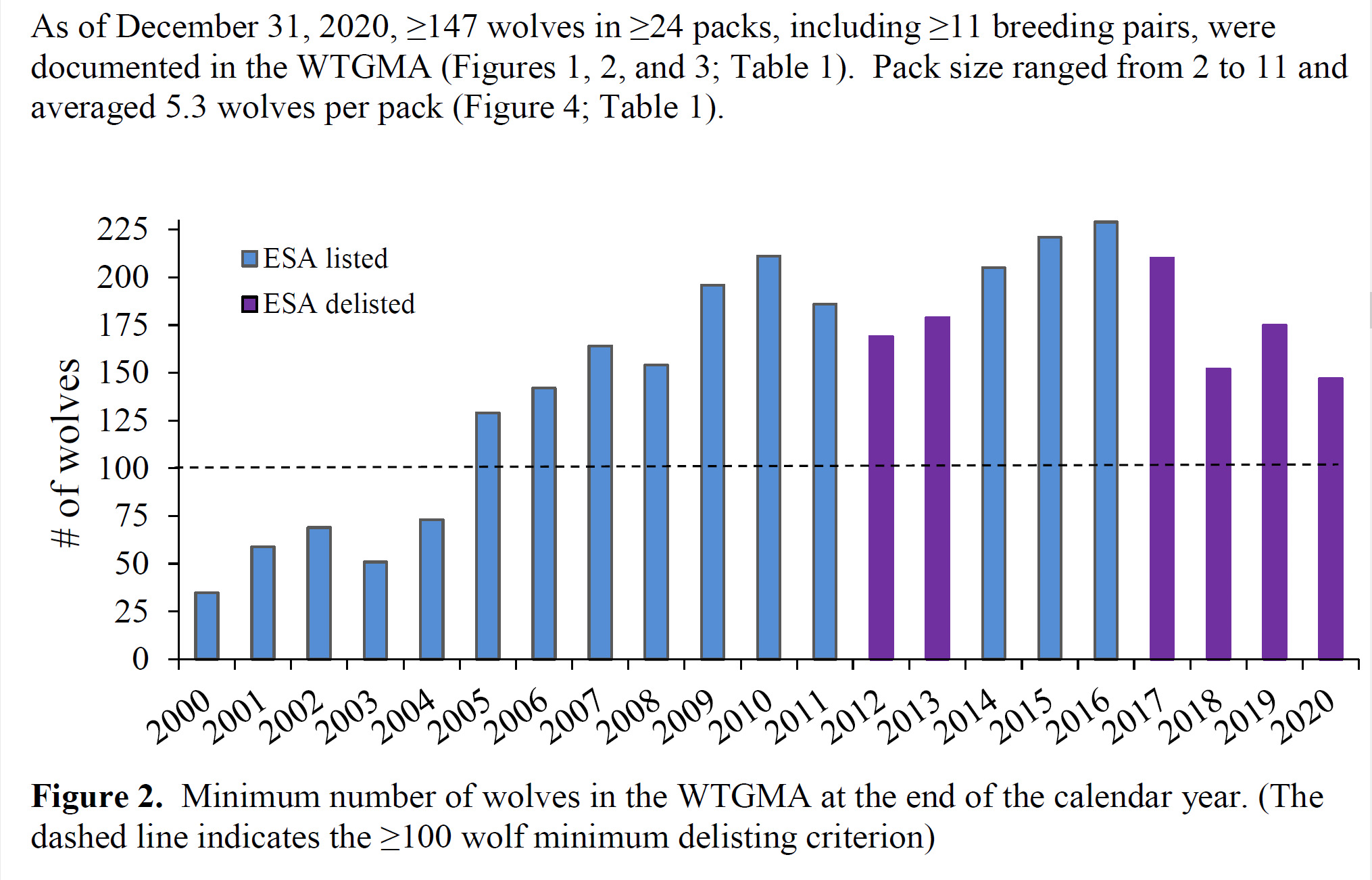Wyoming Gray Wolf Hunting Seasons
No one needs to tell us that Wyoming wolves are suffering as a low priority in Wyoming’s wildlife management. Especially now! You can help us change that! Here’s an opportunity to take immediate action.
- WGF Commission Meeting, Sheridan, WY
- Deadline to submit public comment: June 4, 2021 @ 5 pm.
- Commission meeting to vote on the recommendations, July 13-14, 2021
- Game and Fish Office
Rock Springs, WY
Additional comment for Chapter 47 may be presented before or on Friday, June 4 @ 5 p.m. @ the Commission Meeting in Sheridan, WY.
Wildlife managers are reporting reduced numbers throughout wolf range in Wyoming. The overall statewide Wyoming wolf population is estimated at 327 as the calendar turned to 2020. However, wolves managed by WGFD are perilously low, with 10 breeding pairs and 147 individual wolves
Wyoming wolves are trapped and killed in almost any manner in over 85% of the state. Still, the WGFD continues to reduce the population to minimum numbers.
The final proposal and final chance to comment will go to the WGF Commission at the July 13-14 meeting in Sheridan, WY.
WYOMING WOLF ANNUAL REPORT 2020
We have posted a few key numbers from the annual wolf report 2020, followed by recommended Talking Points for comments to the Commission. WU believes that there is no science-based foundation for “sport” or “trophy” hunting, trapping or managing a population to minimum numbers.
Deadline for Comments @ the WGF Commission Meeting, Friday June 4, 2021 @ 5 p.m.
Wildlife managers are reporting reduced breeding pairs throughout the wolf range in Wyoming.
- The Wyoming Game and Fish Department wolf management objective is to maintain a recovered wolf population in the WTGMA while balancing the need to minimize wolf conflicts with livestock and maintain wild ungulate herds. Wyoming’s Gray Wolf Management Plan also seeks to incorporate public hunting opportunities into its wolf population management strategy.
- Wyoming statewide, at least 327 wolves in ≥44 packs (including ≥23 breeding pairs) on December 31, 2020.
Of the total, there were:
Wolf Trophy Game Management Area (WTGMA), ≥147 wolves and ≥24 packs (including ≥11 breeding pairs),
Yellowstone National Park, ≥123 wolves and ≥9 packs (including ≥7 breeding pairs),
Wind River Reservation, ≥21 wolves and ≥3 packs (including ≥2 breeding pairs),
Predatory animals in Wyoming, ≥36 wolves and ≥8 packs (including ≥2 breeding pairs) resided in areas where wolves are designated primarily as predatory animals in Wyoming. - A total of 119 wolf mortalities were documented statewide in Wyoming in 2020: 71 in the WTGMA, 43 in areas where wolves are primarily designated as predatory animals, 4 in Yellowstone National Park, and 1 in the Wind River Reservation. Causes of mortality included: human-caused = 104 (87% of mortalities); natural = 11 (9%); and unknown = 4 (4%). Forty-three wolves were captured and radio-collared for monitoring and research in 2020.
- A total of 31 wolves were killed during the wolf hunting season in 2020. A total of 2 wolves were trapped in the predatory area.
- Game and Fish has a population goal of 160 wolves outside Yellowstone Park boundaries. If the wolf population outside the Park falls below 100 wolves and 10 breeding pairs, probable relisting will be considered. Thus, 160 wolves are as low as the state can go while still ensuring that 10 federally required breeding pairs remain on the landscape.
- Wyoming officials tallied 13 breeding pairs within their jurisdiction, although two of those pairs resided within the predator zone. Wolf numbers cannot go below 10 breeding pairs in the Trophy Zone without probable relisting.
- This is the outcome Wyoming managers have been seeking, though fewer wolves concern wildlife watchers.
- The balance of Wyoming’s wolf population lives in the “trophy game” area, in the Yellowstone region’s core outside the national parks. Here, WGFD has the most control over numbers, and they use hunting as the primary tool.
- Game and Fish has a long-held population goal of 160 wolves in that region, a count that, models say, is as low as the state can go while still ensuring that 10 federally required breeding pairs remain on the landscape. This year the count came out at 147 wolves, below the 160 target.
- Various human causes of death explained the vast majority of wolf mortalities.
- Game and Fish chalked up 76 head of livestock (54 cattle, 12 sheep, and 10 chickens) and 1 dog statewide in Wyoming in 2020 to wolf predation. Fourteen packs were involved in ≥1 livestock conflict statewide. Forty-three wolves were lethally and legally removed by agencies or the public in an effort to reduce livestock losses to wolves.


Talking Points
It is usually most effective to be persuasive, but not rude, sarcastic or angry. Speak from the heart of one who is more inclined to support our Game & Fish Department if and when doing what is best and right for all residents and visitors in Wyoming, now and into the future. Original words directly from your own heart and mind are more likely to be given consideration than words and phrases that sound scripted.
Focus the energy of your words on wolf hunting, trapping, and snaring reform, and the shifting tide to twenty-first-century wildlife management and public tolerance.
How should you say it?
Wrap your own words around a spectrum of reasons to send wolf trophy trapping and hunting practices to the “gut pile”. Reasons that might speak to:
- emerging trends in wolf wildlife management;
WU believes that the value of wolves to the health of our public landscapes outweighs the recreational opportunity to trap and inhumanely kill year-round without any scientific foundation. We request that the Wyoming Game and Fish Department and the Wyoming Game and Fish Commission permanently end the hunting of wolves in the Trophy Zone. - wolves are not trophies;
The sport hunting of wolves by the general public serves no purpose other than as an expression of “blood lust” and a catalyst for “bragging rights.” There is no derived food value, only ego gratification. Many members of WU were brought up in hunting families and were taught that you only kill what you will eat. WU still subscribes to that value. A trophy hunt of wolves feeds nothing more than the personal ego, and as it all too often occurs within the Predator Zone, is a disgrace to the ethical hunting community. Again, Wyoming’s wolves should have big game status with a year-round closed hunting season. - wolves play a role as apex predators;
Wyoming Untrapped opposes sport hunting of wolves for several reasons, including the significant role wolves play as apex predators within the Greater Yellowstone Ecosystem and how the indiscriminate killing of wolves can have a significant impact on the natural functioning of ecosystems. - they can control their own numbers;
The indiscriminate hunting of wolves can have significant impacts that will reverberate throughout the ecological systems. Wolves are apex species and exist not as individuals but as social units-as packs. Leave them alone and they will flat out control their own numbers (Ordiz, A. et al. 2013.). Witness the Yellowstone wolf population: after 20-plus years, this sub-population has stabilized around 100 individuals–without human intervention, control, or hunting. And the Northern elk herd, a primary food source for a large portion of Yellowstone’s wolves, is on a steady increase. - Principles of the North American Model of Wildlife Conservation (NAMWC);
Wyoming Untrapped also opposes the hunting of wolves because it violates several principles of the North American Model of Wildlife Conservation (NAMWC). First, wildlife is held as a Public Trust Resource by state or federal agencies and is not owned by anyone. This, in conjunction with wildlife being Allocated by Wildlife Law wherein the public – all the public has input into law-making causes us to ask: why, after years of the Commission “taking public comment,” we who have alternate views regarding wolf management have yet to see any significant changes made from any of the original Wyoming Gray Wolf Management Plan? This can hardly be viewed as respecting, let alone incorporating the public’s input. - management condoning and remaining complicit in unethical killing activity;
How can the State of Wyoming and the Game and Fish Commission support, let alone justify a Predator Zone for wolves? Even if the abhorrent killing practices are technically legal within the Predator Zone, they are by every reasonable standard amoral and demonstrate a complete disregard for the principle of “Fair Chase” and the ethical treatment of wildlife. If the Commission remains silent and does nothing to eliminate the Predator Zone, does not call out the inhumane killing practices employed therein, and does nothing to remove the wolf’s Predator Status within 85% of the State, the Commission, and the State are tacitly condoning and remain complicit in this unethical killing activity.
- reconfigure the HA’s and adjust hunting quotas;
Disproportionally high wolf killings near the parks and refuge have undoubtedly impacted the ability of visitors to view wild wolves in the heart of their current range. We strongly urge the Commission to reconfigure the HA’s and adjust hunting quotas to better protect wolves and wolf packs that utilize the parks and refuge for significant portions of their life cycle. Doing so will better serve the desires of tens of thousands of visitors who come to the region each year for a chance to view wolves in the wild- a critical part of the state’s tourist economy. - responsible wolf management;
Wolf management decisions need to be founded on more than hunting quotas, the protection of livestock and for the benefit of “high dollar” game species. Responsible wolf management needs to consider all mortality regardless of cause. It needs to consider ecosystem function- it needs to represent a consensus of the majority of the public, and should not include sport hunting. - policies over best science;
It is WU’s conclusion that the Wyoming Game and Fish Commission, with its proposed 2019 hunting season- a plan structured to maintain just the minimum population necessary to prevent re-listing under the Endangered Species Act, is not doing enough to ensure the wolf’s long-term survival. We feel that the Commission is putting politics over best science. We believe that the Commission is simply not living up to the public’s expectations to manage all wildlife, including wolves for the benefit of all citizens. And we feel the Commission’s proposed Chapter 47, Gray Wolf Hunting Season continues to jeopardize the well-being of the wolves residing within our two premier National Parks and it greatly hinders Wyoming’s wolves from fulfilling their critical ecological niche. - in summary;
Wyoming Untrapped considers it morally and philosophically indefensible to have a sanctioned gray wolf hunting season or to allow wolves to be indiscriminately killed as predatory animals throughout 85 percent of the state. And, although we firmly believe that the Commission’s Draft Chapter 47 Gray Wolf Hunting Season proposal ignores many of the fundamentals of both the North American Model of Wildlife Conservation and the Public Trust Doctrine and that it largely ignores the best available science, we submit these comments for your collective consideration because we regrettably acknowledge that this is the environment we are now having to work within
- wolves are not trophies;
WU wants to make clear that while we respectfully submit these comments for your consideration, in no way should this be construed as support for the sport hunting of wolves, whether as trophy game or as predators.



